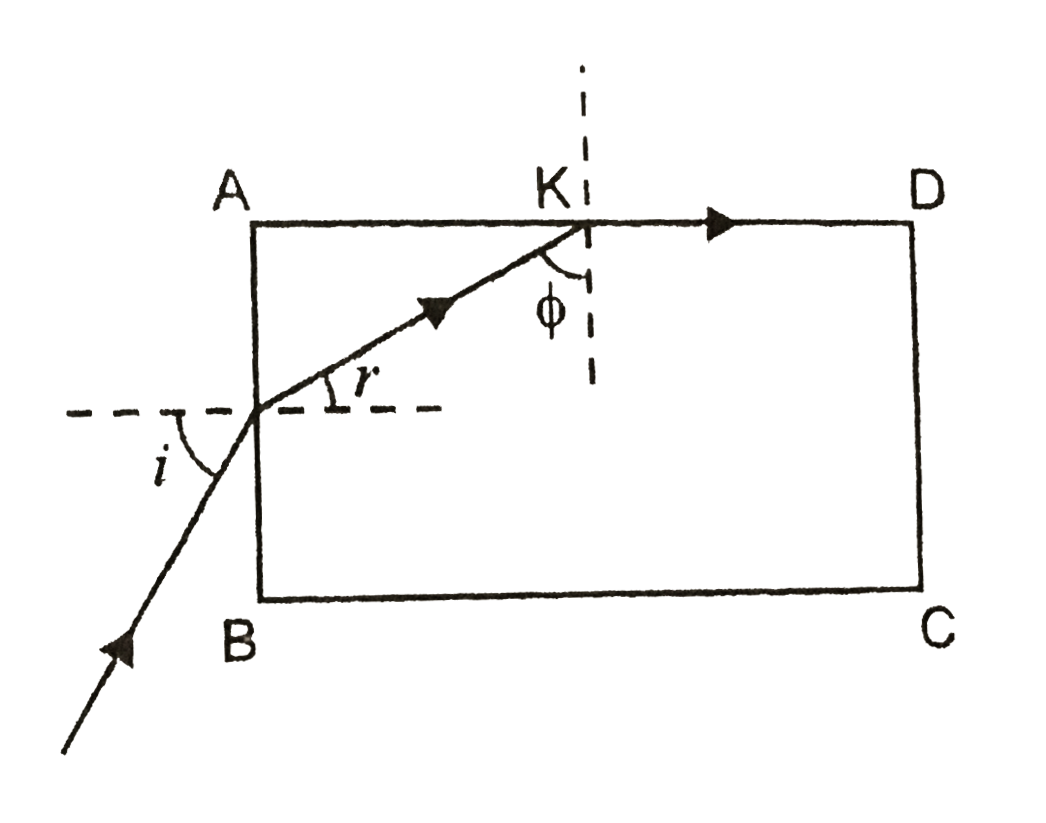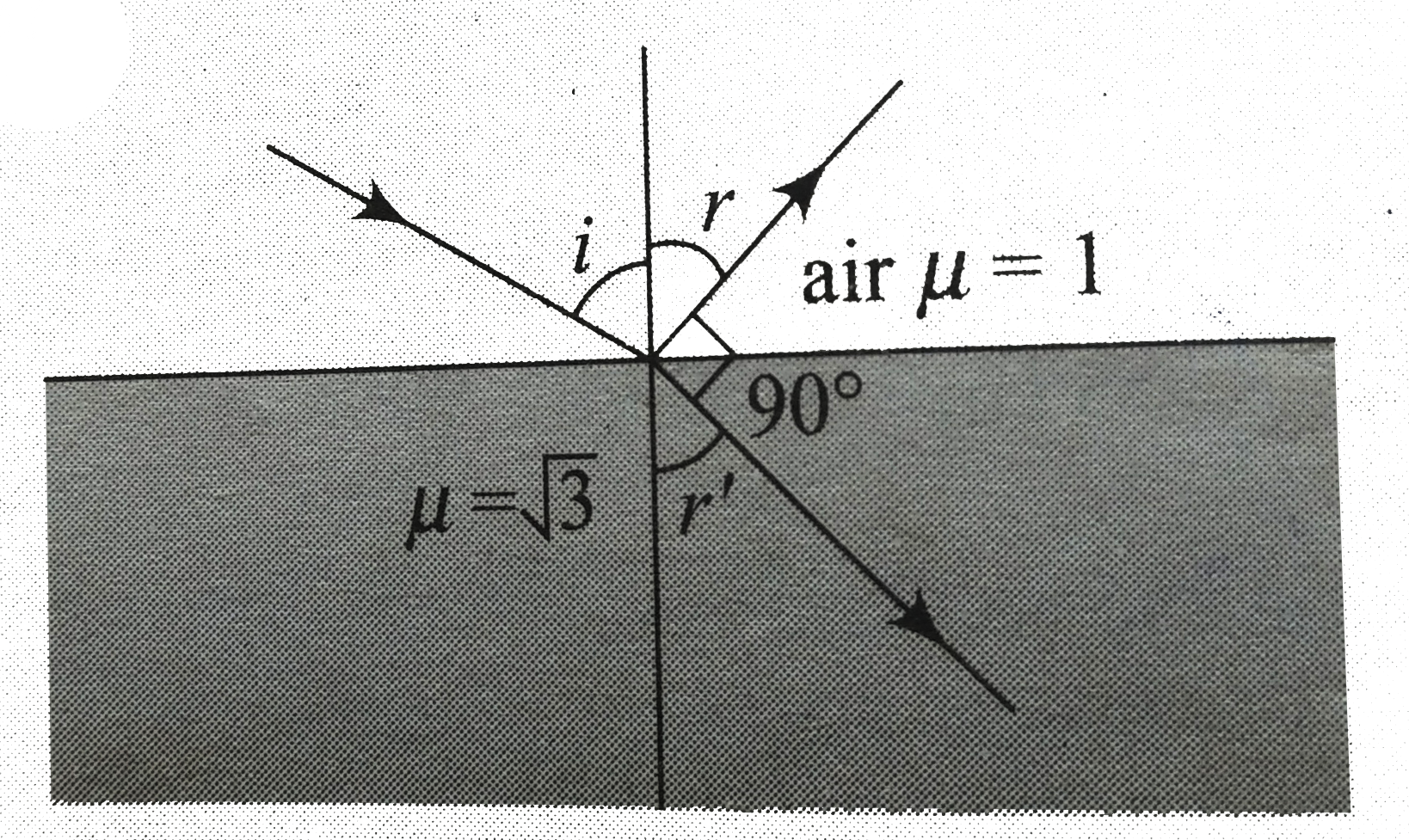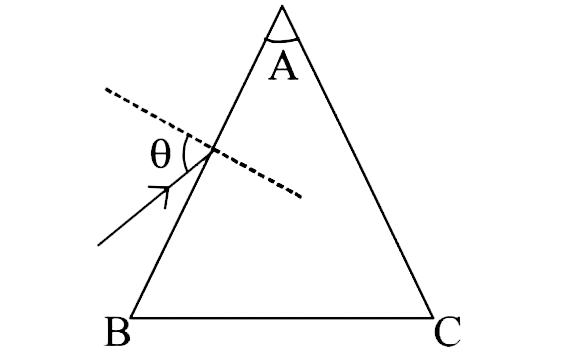Show that for a material with refractive index μ≥√2, light incident at any angle shall be guided along a length perpendicular to the incident face.
In Fig, we have shown a ray of light incident at ∠i on face AB. It is refracted at ∠r and falls on face AD⊥AC at ∠ϕ. This ray will suffer total internal reflection at K and proceed along KD⊥AB, provided.
sinϕ≥1μ
sin(90∘−r)≥1μ or cosr≥1μ
or 1−cos2r≤1−1μ2 or sin2r≤1−1μ2
According to Snell's law, sini=μsinr∴1μ2sin2i≤1−1μ2
sin2i≤μ2−1
ϕ will be smallest when i≈90∘
sin2i=sin290∘=1∴1≤μ2−1 or μ2≥2 or μ≥√2, which was to be proved.
 .
.
Topper's Solved these Questions
- BOOK - PRADEEPCHAPTER - RAY OPTICSEXERCISE - (NCERT)Exercise With Solution38videos
RAY OPTICS
- BOOK - PRADEEPCHAPTER - RAY OPTICSEXERCISE - Higher Thinking Order5videos
RAY OPTICS
- BOOK - PRADEEPCHAPTER - RAY OPTICSEXERCISE - Long Answer (d)6videos
RAY OPTICS
- BOOK - PRADEEPCHAPTER - PROPERTIES OF BULK MATTEREXERCISE - Multiple choice questions7videos
PROPERTIES OF BULK MATTER
- BOOK - PRADEEPCHAPTER - SYSTEMS OF PARTICLES AND ROTATIONAL MOTIONEXERCISE - Assertion- Reason Type questions20videos
SYSTEMS OF PARTICLES AND ROTATIONAL MOTION
Similar Questions
Monochromatic light falls at an angle of incidence i on a slab of a transparent material (refractive index μ). If reflected and refracted rays are mutually perpendicular, find the relation between μ and i.
View SolutionA ray of light is incident on a transparent glass slab of refractive index √3. If the reflected and refracted rays are mutually perpendicular, what is the angle of incidence?
 View Solution
View Solution
Knowledge Check
- Question 1 - Select One
Unpolarised light is incident from air on a plane surface of a meterial of refractive index 'μ'. At a particular angle of incidence 'I', it is found that the reflected and refracted rays are perpendicular to each other.
Which of the following options is correct for this situation?Ai=sin−1(1μ)BReflected light is polarised with its electric vector perpendicular to the plane of incidenceCReflected light is polarised with its electric vector parallel to the plane incidenceDi=tan−1(1μ) - Question 2 - Select One
A ray of light falls on a transparent glass slab of refractive index √2. If the reflected and refracted rays are mutually perpendicular, then the angle of incidence is
Atan−1(√32)Bsin−1(√23)Ctan−1(√2)Dsin−1(√3) - Question 3 - Select One
Unpolarised light is incident from air on a plane surface of a meterial of refractive index 'μ'. At a particular angle of incidence 'I', it is found that the reflected and refracted rays are perpendicular to each other.
Which of the following options is correct for this situation?A(a) i=tan−1(1μ)B(b) Refracted light is polarized with its electric vector parallel to the plane of incidenceC(c) i=sin−1(1μ)D(d) Refracted light is polarized with its electric vector perpendicular to the plane of incidence
Unpolarised light is incident on a plane surface heaving refractive index √3. The angle of incidence at which reflected and refracted rays would become perpendicular to each other is
View SolutionA ray of monochromatic light is incident on the refracting face of a prism (angle 75∘0 . It passes through the prism and is incident on the other face at the critical angle. If the refractive index of the prism is √2 , then the angle of incidence on the first of the prism is
View SolutionA ray of light passes from vacuum into a medium of refractive index n . If the angle of incidence is twice the angle of refraction , then the relation between the angle of incidence and the refractive index is
View SolutionUnpolarized light is incident on a plane glass surface having refractive index . The angle of incidence at which reflected and refracted rays would become perpendicular to each other is :
View SolutionMonochromatic light is incident on a glass prism of angle A. If the refractive index of the material of the prism is μ, a ray, incident at an angle θ, on the face AB would get transmitted through the face AC of the prism provided:
 View Solution
View Solution

